
views
Performing the Test

Cleanse the urinary opening with sterile wipes. It’s important to get rid of any bacteria on the opening that may contaminate your urine and invalidate the test. If you don’t have sterile wipes, use soap and warm water to clean the area. Women should spread their labia and clean the area from front to back. Men should clean the tip of their penis before performing the test. You can usually find sterile wipes at any pharmacy or store that sells home medical supplies.

Fill the sterile container halfway full with urine collected midstream. Begin to urinate into the toilet, then place the container underneath the urine stream. Fill the container with at least 1 to 2 fluid ounces (30 to 59 mL), then finish urinating into the toilet if needed. This method is referred to as the “clean-catch” method and ensures the most accurate test results possible by avoiding contamination by organisms on the skin. You may also see urine collected in this manner called “mid-stream urine.”

Submerge the test strip in the urine so that all test zones are immersed. Each of the strips on the dipstick need to be completely exposed to the urine in order to obtain accurate results. Don’t worry about submerging the stick for any set length of time, unless the manufacturer’s instructions specifically tell you to. In fact, it’s typically recommended that you avoid leaving the dipstick in the urine for too long, as this may impact the test results. You can buy urine dipsticks at any pharmacy or drug store. For best results, test the urine as soon as possible after it leaves the body.Warning: Avoid touching the test zones with your hands when you go to submerge the dipstick. You may inadvertently transfer bacteria from your hands onto the strip.
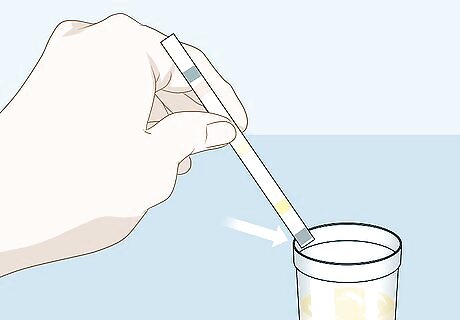
Remove the test strip and gently tap it on the side of the container. Remove the dipstick from the urine as soon as all of the test zones have been completely submerged. Tap it once or twice on the side of the container to make sure that any excess urine on the stick is removed. Be sure you don’t shake the dipstick or tap it too forcefully.
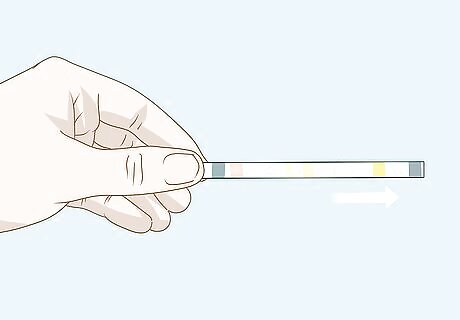
Hold the strip horizontally for at least 30 seconds or more. Holding the dipstick horizontally will prevent the urine from running down the side of the stick and contaminating different test zones. Depending on what you’re testing, you may need to hold the strip for a longer period of time before reading the results. For example, if you’re testing your urine’s bilirubin content, you may only need to wait 30 seconds to get test results. However, if you’re testing for blood or nitrites in the urine, you may need to wait 60 seconds. The color chart will probably include instructions for how long you have to wait to get results for each test zone.
Understanding the Test Results

Use the color chart that came with your dipstick to read the results. Packages of dipsticks typically come with a helpful color chart (usually located on the strip container) that indicates what different colors on the dipstick mean. The rows are on the chart will correspond to a particular test strip on each dipstick. For example, a row labeled “pH” or “Acidity” that begins with a light pink square indicates that the light pink test strip on your dipstick measures your urine’s pH level. The color chart is usually displayed on the package itself, although it may also be provided in the form of a separate sheet.

Check the pH row to determine your urine’s acidity. Urine is usually acidic, with a typical range of 5.0 to 8.0. A high acidity level may indicate some kind of kidney disorder, such as the formation of urinary stones. A low acidity level (i.e., below 5.0) may point to a urinary tract infection (UTI). Note that your urine’s acidity level may also be influenced by your diet. Eating a lot of protein may make your urine more acidic, while eating a lot of dairy or vegetables may make your urine less acidic. Certain medications, such as urinary acidifiers, may also impact the pH level of your urine.Tip: To avoid interfering with the results of your dipstick test, avoid eating a lot of protein, vegetables, or dairy products in the 24 hours leading up to your exam.

Look at the color of the concentration row to see if you’re dehydrated. This row may also be called “Specific Gravity.” A higher than normal concentration typically occurs when you’re not getting enough fluids. The normal range of specific gravity is 1.001 to 1.035. This test strip specifically measures the concentration of particles in your urine. Urine that is less concentrated than normal may be the result high fluid intake, diabetes, kidney disease, or an inability to produce antidiuretic hormone.
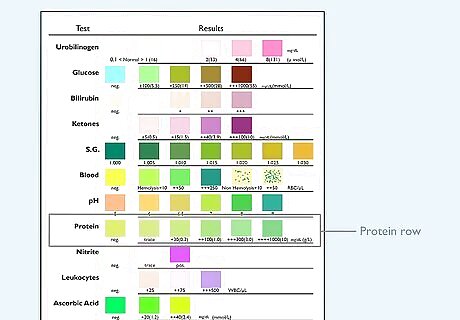
Refer to the protein row to gauge how healthy your kidneys are. The amount of protein in a typical healthy person’s urine is so low that it doesn’t even register on a test strip. Therefore, if your dipstick registers a significant amount of protein in your urine, this may be a sign of a problem with your kidneys. This depends in part on how much protein is present in your urine. A small amount of protein isn’t necessarily a cause for concern. If you detect protein in your urine, the best thing to do is to get it checked out by a doctor just to be safe. Protein in the urine may be caused by urinary tract infection, kidney damage, hypertension, diabetes, or pre-eclampsia.
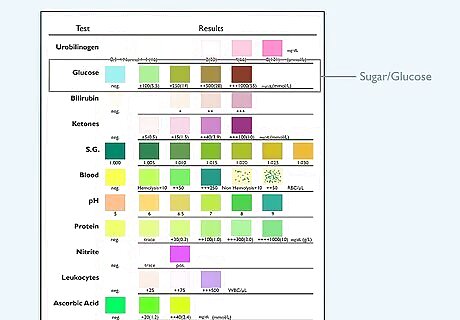
Note whether your urine’s sugar content may point to diabetes. Sugar or glucose in your urine may be caused by endocrine abnormality, which itself may be the result of diabetes. However, the presence of sugar in your urine is not enough to make a full diagnosis, so see your doctor for further testing. For instance, a high sugar content in urine can also be caused by pregnancy or by taking corticosteroids. The presence of ketones in your urine may also indicate diabetes. Like with protein, the amount of glucose and ketones in a healthy person’s urine ought to be so low that a dipstick wouldn’t even register them.
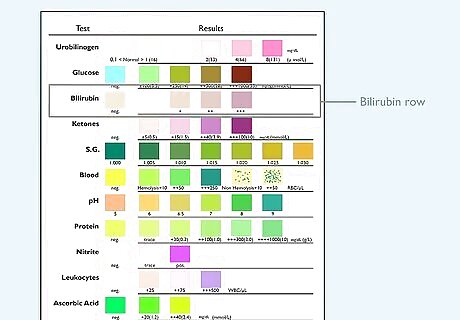
Check the color on the bilirubin row to assess your liver health. Bilirubin is the product of red blood cell breakdown. Normally, bilirubin is processed and removed by your liver. Therefore, if bilirubin is showing up in your urine, this may indicate that your liver isn’t functioning properly. Bilirubin in the urine may also be caused by a problem with the drainage of bile into the gut, since bilirubin normally becomes part of your body’s bile.
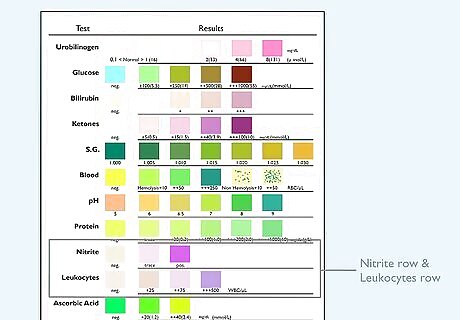
Read the nitrite and leukocytes rows for evidence of a UTI. Nitrites and leukocytes, which are a product of white blood cells, are typically present when your body is fighting an infection. However, leukocytes in your urine may also point to a problem with your kidneys, so it’s best to get an official diagnosis if you either of these substances show up on your dipstick. Note that you can also have a urinary tract infection without having high levels of either nitrites or leukocytes. Do not rely on a dipstick test alone for an official diagnosis.
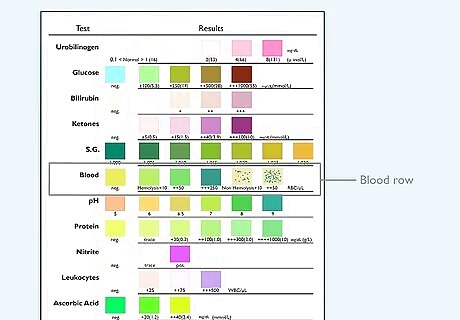
Look at the blood row for signs of more serious health problems. In a healthy person, there should not be any detectable amount of blood in the urine. There are many potential causes of blood showing up in your urine, so it’s important to see a doctor if this is the case. Some potential causes of blood in the urine include: Urinary tract infection Kidney disease Inflammatory lesions of the urinary tract Renal damage Kidney stones

Speak with a doctor to get an official diagnosis. Although a dipstick urinalysis can point to a specific illness or other medical problem, other tests will likely need to be performed in order to officially diagnose any issue you may be dealing with. Take a photo of your dipstick or write down the information on it so you can tell the doctor exactly what your test indicated. Note that your doctor may have you perform another dipstick urinalysis in their office in order to confirm the accuracy of your own test results. If you have abnormal dipstick readings and other issues like difficulty urinating or increased frequency, your doctor might prescribe antibiotics.
















Comments
0 comment